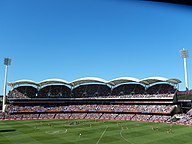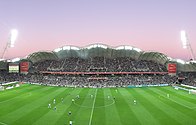Australia is unique among major sporting markets in having four football codes competing for market share. The irony is that the two international games, football (soccer) and rugby union, are getting trounced by the two parochial codes, rugby league and Australian Football, which are both fast and furious, and both built on deep tribal roots.
Paul Sheehan, 2010[1]
Football in Australia refers to numerous codes which each have major shares of the mainstream sports market, media, broadcasting, professional athletes, financial performance and grassroots participation: Australian rules football, rugby league, rugby union and soccer (known in many other countries as "football"). There are four pre-eminent professional football competitions played in Australia: the Australian Football League (Australian football), the National Rugby League (rugby league), Super Rugby (rugby union) and the A-League (soccer). By most measures, including attendance, television audience and media presence across the most states, Australian football is the most popular nationally. However, in the states of New South Wales and Queensland, rugby football (including league and union) is overall the most watched and receives the most media coverage, especially the Rugby League State of Origin contested between the two states referred to as "Australian sport's greatest rivalry".[2][3][4][5] In recent times, there has been an increase in popularity in Australian football and corresponding decrease in popularity of Rugby union in New South Wales and Queensland. Soccer, while extending its lead in participation rate, particularly in the large cities, and improving its performance at the FIFA World Cup and at the FIFA Women's World Cup, continues to attract the overall lowest attendance, as well as media and public interest, of the four codes.
In Australia, it is not unusual for football fans to follow or play more than one code of football and spectate major events from multiple different codes, though strong lifelong allegiances are evident in some where football cultures are most ingrained. Immigration to Australia and internal migration have had a significant effect on football followings in parts of Australia, and even have an influence on where Australians move.[6]
Prior to the Federation of Australia, there was no dominant football code and football was played under a variety of rules since 1829. By the 1860s, Australian football and rugby became entrenched in Melbourne and Sydney, respectively. The first intercolonial football matches were being played by the 1870s and led to the formation of the first intercolonial governing bodies in Australian rules and rugby. Soccer or "British Association Football" was first introduced in the 1870s; although it has struggled against the full contact codes, it has increased in popularity since the 1890s. Women's soccer dominated female participation from the 1920s until recent times, when the organisation of Women's Australian football saw it boom in popularity. Strong Australian regional rivalries have helped keep a regional football code divide in Australia, popularly known as the "Barassi Line", strong for generations. This divide was still strongly evident in the 1980s after the first national competitions became established. Rugby continued to dominate in Queensland and New South Wales and Australian football, while still being played throughout, dominated the rest of the country. Other traditional divisions have also continued to some extent, including rugby league and rugby union's class/socio economic division and soccer's dominance amongst some minority migrant communities. Most attempts to move outside these traditional boundaries have been largely unsuccessful.
The different codes attract different participation levels that reflect historical trends. Soccer, nationally, has substantially more participants than any other code, and is particularly popular with junior participants. However, Australian football now has much higher participation rates amongst Australia's indigenous communities and women than the other codes.
Australia competes internationally in almost all football codes with national football teams. Nationally the most popular are the "Matildas" & "Socceroos" (soccer), the "Wallabies" (rugby union) and "Kangaroos" (rugby league).
- ^ Sheehan, Paul (4 October 2010). "Fast and furious, a league apart". The Sydney Morning Herald. Retrieved 11 September 2013.
- ^ "The countdown is on to sport's greatest rivalry!". melbournestorm.com. 9 May 2012. Archived from the original on 13 May 2012. Retrieved 17 October 2012.
- ^ Tasker, Norman (2005). State of Origin: twenty-five years of sport's greatest rivalry. Caringbah, New South Wales: Playright Publishing. ISBN 0949853933.
- ^ "Rep season officially launched". sportsaustralia.com. 5 April 2006. Archived from the original on 1 May 2013. Retrieved 17 October 2012.
- ^ "Eye of the storm". The Sydney Morning Herald. 23 June 2006. Retrieved 17 October 2012.
- ^ Your choice of footy team can predict where you'll move Aidan Devine, The Telegraph 4 Jun 2018
© MMXXIII Rich X Search. We shall prevail. All rights reserved. Rich X Search




